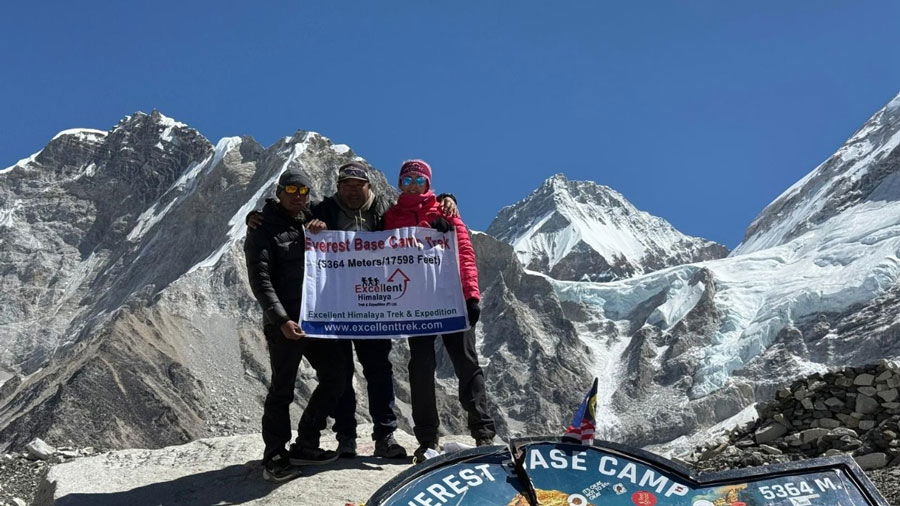Is Everest Base Camp the Top of Everest?
When people hear the words “Everest Base Camp,” they often imagine reaching the very peak of Mount Everest, the tallest mountain in the world. It’s easy to see why. The name sounds intense and adventurous. But is Everest Base Camp the top of Everest? The short answer is: No. It’s not the summit, but it’s still one of the most thrilling trekking experiences you can have.
Think of Everest Base Camp (often called EBC) like the lobby of a skyscraper—you’re in the building, you’re part of the action, but you’re nowhere near the rooftop. Let’s explore what EBC really is, how it compares to the summit, and why so many people dream of getting there.

Table of Contents
- What is Everest Base Camp?
- Is Everest Base Camp the Top of Everest?
- How High is Everest Base Camp?
- The Real Summit of Everest
- Why People Confuse Everest Base Camp with the Everest Summit
- The Journey to Everest Base Camp
- Trekking to EBC vs. Climbing Everest
- Physical Challenges at EBC
- Life at Everest Base Camp
- Weather and Conditions at EBC
- Costs and Time Commitment
- What You’ll See on the Trek
- Who Can Trek to EBC?
- Why EBC is Still a Big Achievement
- Final Thoughts: Everest Summit vs. Everest Base Camp
- FAQs
What is Everest Base Camp?
Everest Base Camp is the staging area for climbers attempting to reach the summit of Mount Everest. There are actually two base camps—South Base Camp in Nepal and North Base Camp in Tibet. The South Base Camp is the more popular trekking destination.
It’s the spot where climbers rest, train, and prepare their gear before attempting to reach the summit. It’s not just a campsite; it’s a mini-community of tents, climbers, guides, and supplies. Think of it as the mountain’s waiting room.
Is Everest Base Camp the Top of Everest?
Let’s set the record straight: Everest Base Camp is not the top of Mount Everest. The summit of Everest is a whole different ballgame—literally miles above.
EBC sits at around 5,364 meters (17,598 feet), while the summit of Everest is 8,848.86 meters (29,031.7 feet) high. That’s a difference of over 3,484 meters (11,433 feet)!
So, if EBC is the lobby, the summit is the penthouse—accessible only to the few who can make it all the way up.
How High is Everest Base Camp?
Everest Base Camp on the south side in Nepal is 5,364 meters above sea level. That’s already higher than most peaks in the world.
To give you an idea, it’s almost as high as Mount Kilimanjaro’s summit, Africa’s tallest mountain! You’re not on top of the world, but you’re definitely up there.
The Real Summit of Everest
The true summit of Mount Everest is at 8,848.86 meters, making it the highest point on Earth. Only elite climbers, after months of training and with help from Sherpas and oxygen tanks, make it to this extreme altitude.
The final climb is known as the “Death Zone”, where oxygen levels are so low that the human body can’t survive for long.
Why People Confuse Everest Base Camp with the Everest Summit
Many people assume Everest Base Camp is the summit because of the name “Everest.” When someone says, “I’m going to Everest,” it sounds like they’re going to the top, doesn’t it?
Also, photos from EBC look dramatic, with towering peaks and glaciers in the background, giving the impression that you’ve reached the top of the world.
The Journey to Everest Base Camp
Trekking to EBC is an adventure of its own. Most people fly into Lukla, a tiny mountain airport, and trek for 8–12 days through the Khumbu Valley, stopping at villages like Namche Bazaar and Tengboche.
The trail is surrounded by snowy mountains, Buddhist monasteries, yaks, and prayer flags fluttering in the wind. It’s not just a hike—it’s a cultural journey.
Trekking to EBC vs. Climbing Everest
Trekking to EBC is like watching a major concert from the front row, while climbing Everest is like being the performer on stage.
Trekking to EBC requires good fitness but no technical climbing skills.
Climbing Everest demands years of mountaineering experience, costly gear, permits, and mental toughness.
Only around 500 people reach the summit each year, while tens of thousands make it to Base Camp.
Physical Challenges at EBC
Don’t be fooled—getting to Base Camp is no walk in the park. At high altitudes, your body gets less oxygen, and you might suffer from Altitude Sickness.
You’ll be hiking for hours each day, often in thin air and cold temperatures. But with proper preparation, most people can do it safely.
Life at Everest Base Camp
During peak seasons, EBC turns into a buzzing tent city. Climbers and trekkers share stories, guides prepare meals, and teams get ready for their summit push.
There’s no Wi-Fi (except maybe a weak signal), no hot showers, and you sleep in a tent. But there’s an energy that makes it unforgettable.
Weather and Conditions at EBC
Expect cold, dry, and windy weather. Temperatures can drop well below freezing, especially at night. The best time to trek is during spring (March–May) and autumn (September–November).
The views are stunning, but storms can roll in quickly, making weather a constant concern.
Costs and Time Commitment
A trek to EBC typically takes 12–14 days round trip and can cost $1,200–$2,000 USD, depending on your route, guide, and services.
Climbing Everest, on the other hand, takes over a month and can cost $30,000–$60,000 or more!
What You’ll See on the Trek
From swaying suspension bridges to colorful villages and epic mountain vistas, the trek offers one jaw-dropping moment after another.
You’ll pass icefalls, prayer wheels, glaciers, and some of the most scenic trails on Earth.
Who Can Trek to EBC?
Almost anyone in decent physical shape can trek to Base Camp. You don’t need to be an athlete or a climber.
With the right training, pacing, and altitude awareness, even people in their 60s and 70s have made it successfully.
Why EBC is Still a Big Achievement
Even though it’s not the Everest summit, reaching Everest Base Camp is an incredible feat. It’s a test of endurance, spirit, and adventure.
It’s the closest you can get to Everest without climbing it, and many who go say it’s the journey of a lifetime.
Final Thoughts: Everest Summit vs. Everest Base Camp
So, is Everest Base Camp the top of Everest? Definitely not. But does it matter? Not really.
For most people, reaching EBC is about pushing boundaries, seeing one of the most spectacular places on Earth, and walking in the footsteps of legends.
You don’t need to stand on top of the world to feel like you’ve achieved something great. Sometimes, just being near it is enough to change your perspective forever.
FAQs
1. Is Everest Base Camp harder than climbing Everest?
No, Base Camp is much easier. It’s a trek, not a climb. Climbing Everest requires advanced mountaineering skills, oxygen tanks, and serious risk.
2. Can you see the summit of Everest from Base Camp?
Surprisingly, no. The view of the actual summit is blocked by other peaks like Nuptse. But you’ll still see stunning mountain views.
3. Do people live at Everest Base Camp?
Not permanently. During climbing season, guides and climbers stay at EBC, but it’s seasonal and no one lives there year-round.
4. How cold is it at Everest Base Camp?
Temperatures can dip below -10°C (14°F) at night. During the day, it can be chilly but sunny, especially in trekking season.
5. Is a guide necessary for trekking to EBC?
While not mandatory, having a guide is highly recommended for safety, local knowledge, and navigation, especially if you’re new to high-altitude trekking.




